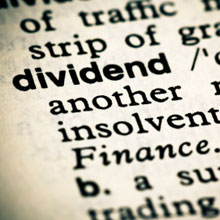Article by Investment U

Today there are only 10 dividend-paying stocks that have increased their dividend payments consistently for over 50 years.
If you’re an income-seeking individual, there may be no better time than right now to pick up shares of dividend-paying stocks.
After all…
- Most returns from U.S. Treasury bonds are in the negative when taking inflation into account.
- Money market accounts average returns of just 0.02%.
- And regardless of what the Fed says, there’s no magic crystal ball that can predict exactly when things will turn around.
But according to Marketwire, “In 2012, S&P 500 companies are on pace to pay out a record amount in dividends…”
What’s more, U.S. corporations are also sitting on a record amount of cash, $2 trillion total. And more and more companies are starting to use their enormous cash reserves to reward income seeking investors…
How to Earn More With “Boring” Dividends
But how do you get the most out of your dividend investments?
Senior Analyst Marc Lichtenfeld reveals one of the most important things to consider is a company’s payout ratio.
This simply measures the percentage of a company’s earnings that it paid out to shareholders as dividends. It’s important to note that Marc uses cash flow from operations rather than earnings. This is because accountants can play some pretty slick tricks with earnings figures.
Marc tells me that he tries to avoid companies with a payout ratio higher than 75%. At this point, if that firm’s cash flow takes a hit, more than likely it’ll be forced to cut its dividend.
Which brings me to another important thing to look for – reliability of a company paying and increasing its annual dividend payments.
In fact, today there are only 10 companies that have increased their dividend payments consistently for over 50 years.
| Company | Symbol | Since | Last Raise |
| 3M Company | MMM | 1959 | 7% (February 2012) |
| American States Water Company | AWR | 1955 | 8% (April 2011) |
| Cincinnati Financial Corporation | CINF | 1961 | <1% (August 2011) |
| Diebold Incorporated | DBD | 1954 | 2% (February 2012) |
| Dover Corporation | DOV | 1956 | 15% (August 2011) |
| Emerson Electric Co. | EMR | 1957 | 16% (November 2011) |
| Genuine Parts Company | GPC | 1957 | 10% (February 2012) |
| Proctor & Gamble | PG | 1957 | 7% (April 2012) |
| Northwest Natural Gas | NWN | 1956 | 15% (August 2011) |
| Vectren Co. | VVC | 1960 | 3% (November 2011) |
[Reference: The Dynamic Dividend]
These certainly aren’t exciting companies per se – there’s no interesting stories or technological breakthroughs here. But the real thrill of investing for me isn’t what a company does, it’s how much money I make in the end.
Just take a look at Proctor & Gamble…
According to Wharton School of Business Professor Jeremy Siegel, P&G would’ve turned a $10,000 investment in 1957 into more than $4 million today. Not bad for a “boring” investment in my opinion.
What’s more, even after 55 years of consecutive dividend increases for its shareholders, P&G still expects to increase its dividend 10% per year going forward.
But you don’t even need to wait 55 years to see massive gains from reinvested dividends.
Take for instance an example Marc recently wrote about using the stock of Kimberly-Clark (NYSE: KMB).
As Marc wrote, this stock “isn’t going to get anyone’s adrenaline pumping. I mean, you can only get so excited about Huggies, Kleenex and Scott paper towels.”
But Kimberly-Clark pays a healthy 4.1% dividend yield, or $2.96 per share. If you bought $10,000 worth of stock, reinvested the dividends, and the dividend grew 9% per year like it has for the past 10 years, in 2022 your stock would yield nearly 14% on your original investment. Instead of $416 in income that you receive the first year, you’d get paid $1,388.
And if you could keep on reinvesting the dividends, the compounding machine kicks into overdrive the longer it goes. In 15 years, you’d receive $2,900 per year in dividends, or a 29% yield on your original cost. And in 20 years, $6,482 for a ridiculous 65% yield. So you’d make your original investment back every 18 months at that point.
These numbers do assume the stock price rises 5% per year, but that’s not too far-fetched considering it’s risen 9% per year over the last 10 years.
The bottom line: It really pays to have a sound dividend investment strategy. And it’s really never too late to get started. In just 10 or 15 years, you can really start to cash in.
Good Investing,
Mike Kapsch
Article by Investment U